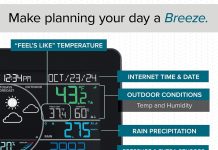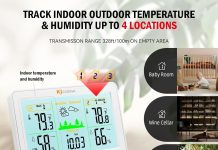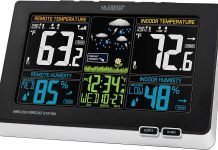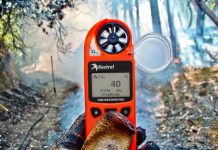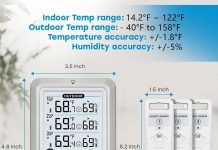Curiosity strikes us weather enthusiasts as we wonder, “Can I use a home weather station for storm chasing?” With the allure of powerful storms and the urge to witness nature’s raw energy up close, it’s natural to ponder if our trusty weather station at home can provide the tools needed for this adventurous pursuit. In this article, we will explore the capabilities of a home weather station and whether it can aid us in our storm-chasing endeavors.
Review contents
Choosing the Right Home Weather Station
When it comes to storm chasing, having a reliable and accurate home weather station is essential. But with so many options available in the market, it can be overwhelming to choose the right one. Understanding the different types of weather stations and considering certain factors can help you make an informed decision.
Understanding the Different Types of Weather Stations
There are generally two types of weather stations: professional-grade and consumer-grade. Professional-grade weather stations are typically used by meteorologists and require extensive knowledge to operate. On the other hand, consumer-grade weather stations are designed for everyday weather enthusiasts and are relatively easier to set up and use.
Consumer-grade weather stations can further be categorized into three types: standalone, integrated, and modular. Standalone weather stations come preassembled and are ready to use out of the box. Integrated weather stations are designed to be connected to a personal computer or smartphone, allowing you to access real-time data from anywhere. Modular weather stations offer flexibility and customization options, allowing you to choose and add sensors based on your specific needs.
Considerations when Purchasing a Weather Station
Before purchasing a home weather station for storm chasing, there are a few considerations to keep in mind. First and foremost, assess your needs and determine the specific weather data you want to monitor. This will help you choose a weather station with the appropriate sensors.
Another important factor to consider is the durability and weather resistance of the weather station. Storm chasing often involves being exposed to harsh weather conditions, so you want a weather station that can withstand rain, wind, and extreme temperatures. Additionally, consider the wireless range of the weather station, especially if you plan to monitor data from a significant distance.
Lastly, it’s always helpful to read reviews and recommendations from other storm chasers or weather enthusiasts. Their experiences and insights can give you a better idea of the reliability and accuracy of different weather station brands.
Recommended Brands for Storm Chasing
While there are numerous brands available in the market, certain brands have gained a reputation for their quality and performance in storm chasing scenarios. Some trusted brands include Davis Instruments, Ambient Weather, AcuRite, and Oregon Scientific. These brands offer a range of weather stations with various features, ensuring that you find one that suits your specific storm chasing needs.
Features to Look for in a Home Weather Station
To make the most out of your storm chasing adventures, it’s important to choose a home weather station with the right features. Here are some key features to look for:
Real-Time Data Monitoring
Having access to real-time data is crucial during storm chasing. Look for a weather station that offers real-time updates and allows you to monitor data from anywhere, either through a personal computer or smartphone app. This feature ensures that you stay informed about the current weather conditions and make timely decisions.
Multiple Sensors
Different weather phenomena require different sensors. Look for a weather station that comes with a variety of sensors to monitor various parameters such as temperature, humidity, wind speed, wind direction, barometric pressure, and rainfall. Having multiple sensors increases the accuracy and reliability of the data collected, providing you with comprehensive information for storm chasing.
Wireless Connectivity
Since storm chasing often involves being mobile, having a weather station with wireless connectivity is essential. Look for a weather station that can connect to your personal computer or smartphone via Wi-Fi or Bluetooth. This allows you to access the data remotely, eliminating the need for physical connections and ensuring convenience during your storm chasing expeditions.
Wind Speed and Direction Measurement
Wind plays a significant role in storm development, making it crucial to have accurate wind speed and direction measurements. Look for a weather station that offers an anemometer to measure wind speed and a wind vane to determine wind direction. These sensors will help you track and analyze the wind patterns associated with severe weather conditions.
Barometric Pressure Monitoring
Understanding changes in barometric pressure can provide valuable insights into weather patterns and storm development. Look for a weather station with a barometer to monitor barometric pressure. This feature will help you identify atmospheric fluctuations and anticipate potential storm systems.
Rainfall Measurement
Precipitation is a key factor in storm chasing, as heavy rainfall often accompanies severe weather events. Look for a weather station with a rain gauge to measure rainfall accurately. This information will contribute to your understanding of storm systems and rainfall rates, enabling you to stay informed during storm chasing activities.
Temperature and Humidity Monitoring
Temperature and humidity are fundamental parameters in assessing storm potential and severe weather conditions. Look for a weather station that includes sensors for temperature and humidity monitoring. This will allow you to track changes in atmospheric conditions and predict weather patterns.
GPS Capabilities
Having GPS capabilities in your home weather station can be a valuable asset during storm chasing. Look for a weather station with GPS functionality to accurately record and track your location while collecting data. This feature will enable you to document and analyze storm conditions with precise geographic information.
Setting Up Your Home Weather Station
Once you’ve chosen the right weather station for storm chasing, it’s time to set it up properly. Here are the steps to follow:
Determining the Best Location for Your Weather Station
Choosing the optimal location for your weather station is crucial to ensure accurate and reliable data. Look for an open and unobstructed area away from buildings, trees, and other potential sources of interference. Ideally, the weather station should be elevated to capture an accurate representation of the weather conditions in your area.
Mounting the Weather Station
Once you’ve identified the location, make sure to securely mount the weather station according to the manufacturer’s instructions. This typically involves attaching the sensors to a pole or a tripod. Ensure that the weather station is stable and properly aligned to accurately capture weather parameters.
Calibrating the Sensors
Before relying on the data collected by your weather station, it’s important to calibrate the sensors. Follow the calibration procedures provided by the manufacturer to ensure accurate measurements. Calibration typically involves comparing the readings of your weather station with known reference values and adjusting the sensors accordingly.
Connecting to a Personal Computer or Smartphone
To make the most out of your home weather station, connect it to your personal computer or smartphone using the manufacturer’s recommended software or app. This will allow you to access real-time data, analyze historical trends, and receive alerts or notifications when severe weather conditions are detected.
Configuring the Weather Station Software
Once you’ve connected the weather station to your computer or smartphone, configure the software settings according to your preferences. This includes selecting the units of measurement, adjusting the reporting intervals, setting up alerts, and customizing the display of data. Take some time to familiarize yourself with the software interface to optimize your storm chasing experience.
Interpreting Weather Data for Storm Chasing
Accurate interpretation of weather data is essential for successful storm chasing. Here are some key considerations:
Understanding Weather Patterns and Precursors
To effectively chase storms, it’s important to understand weather patterns and precursors that indicate the potential for severe weather. Familiarize yourself with meteorological concepts such as air masses, fronts, instability indices, and wind shear. Stay updated on weather forecasts and learn to interpret the data from your home weather station in the context of these patterns and precursors.
Analyzing Meteorological Data
Regularly analyze and compare the meteorological data collected by your weather station with other reliable sources, such as radar imagery and weather models. This will help you validate your observations and gain a better understanding of the current weather conditions. Look for trends and anomalies in the data that can provide insights into storm development and progression.
Identifying Severe Weather Conditions
Utilize the data from your home weather station to identify severe weather conditions, such as rapid changes in temperature, significant drops in barometric pressure, or sudden shifts in wind direction. Stay alert for these indicators and cross-reference them with official weather reports or observations from nearby weather stations. This will help you make informed decisions and ensure your safety while storm chasing.
Tips for Storm Chasing with a Home Weather Station
While storm chasing can be an exhilarating experience, it’s important to prioritize safety and make the most of your home weather station. Here are some tips:
Staying Safe during Storm Chasing
Always prioritize safety when storm chasing. Never put yourself or others at risk in pursuit of severe weather. Familiarize yourself with storm safety protocols, such as seeking shelter during lightning or tornado warnings. Remember that your home weather station can provide valuable data, but it’s crucial to prioritize your personal well-being and follow official weather advisories and instructions.
Utilizing Cloud-based Weather Services
Take advantage of cloud-based weather services that allow you to store and analyze your weather station data remotely. These services often provide enhanced features, such as data visualization tools and historical weather archives. Additionally, cloud-based services ensure that your data is accessible even if your personal computer or smartphone is not available.
Collaborating with Other Storm Chasers
Join online communities or local storm chasing groups to collaborate and share insights with fellow storm chasers. Engaging in discussions and exchanging information can provide valuable perspectives and enhance your storm chasing experience. Sharing data and observations from your home weather station can contribute to a wider understanding of storm systems and improve storm prediction capabilities.
Maintaining and Troubleshooting Your Weather Station
Regularly maintain and calibrate your home weather station to ensure accurate readings. Clean the sensors and check for any damage or wear. Troubleshoot any connectivity issues or software glitches promptly. Frequently update the firmware and software of your weather station to benefit from the latest features and bug fixes.
Limitations of Using a Home Weather Station for Storm Chasing
While home weather stations can be valuable tools for storm chasing, they do have some limitations. It’s essential to be aware of these limitations to make informed decisions while analyzing and interpreting the data:
Reliability and Accuracy
While advancements in technology have improved the reliability and accuracy of home weather stations, they may not always match the precision of professional-grade meteorological equipment. Factors such as sensor quality, calibration, and environmental conditions can impact the accuracy of the data. Always cross-reference your observations with official weather reports for a comprehensive analysis.
Data Lag and Connectivity Issues
Home weather stations rely on wireless connectivity to transmit data to personal computers or smartphones. However, data lag and connectivity issues can occur, especially in remote or less populated areas. It’s important to consider this potential delay when using the data for storm chasing purposes. Regularly check your connectivity and ensure that the data being displayed is up-to-date.
Limited Coverage Range
Home weather stations typically have a limited coverage range, which means they can only provide accurate data within a certain distance from their location. This range varies depending on the transmitting power of the weather station and potential obstructions. It’s crucial to understand the limitations of your weather station’s coverage range and analyze the data accordingly.
Dependence on Local Weather Conditions
Home weather stations primarily collect data from their immediate surroundings, making them heavily dependent on local weather conditions. This means that the data collected may not be representative of the larger weather system or regional weather patterns. Consider supplementing your observations with data from nearby weather stations or official weather reports to gain a broader perspective on storm conditions.
In conclusion, a home weather station can be a valuable tool for storm chasers, providing real-time data and insights into weather conditions. By understanding the different types of weather stations, considering the key features, and setting up the station correctly, you can enhance your storm chasing experiences. Remember to interpret the data accurately, prioritize safety, and be aware of the limitations of using a home weather station for storm chasing.


